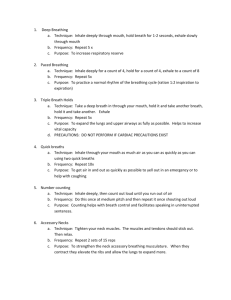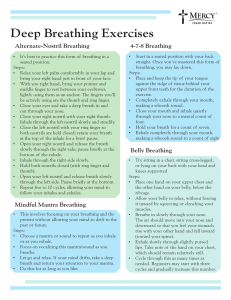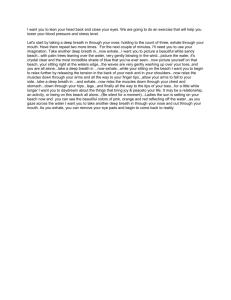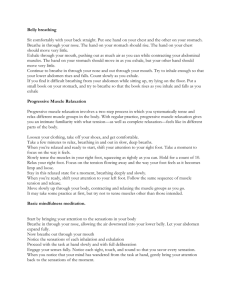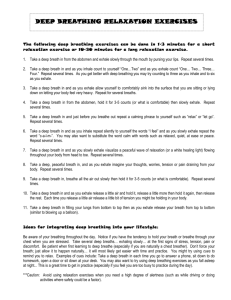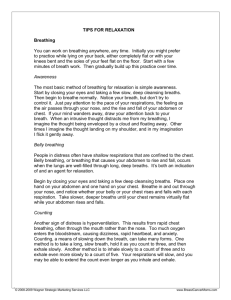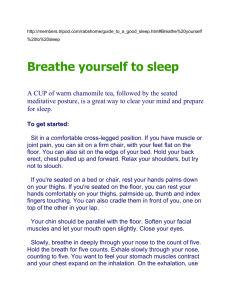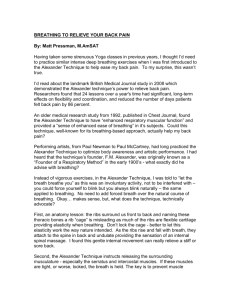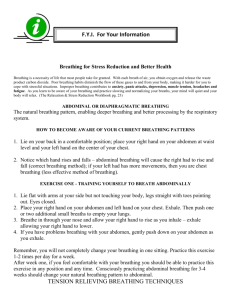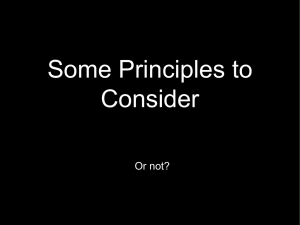Stress & Trauma - Immigrant Solidarity Network
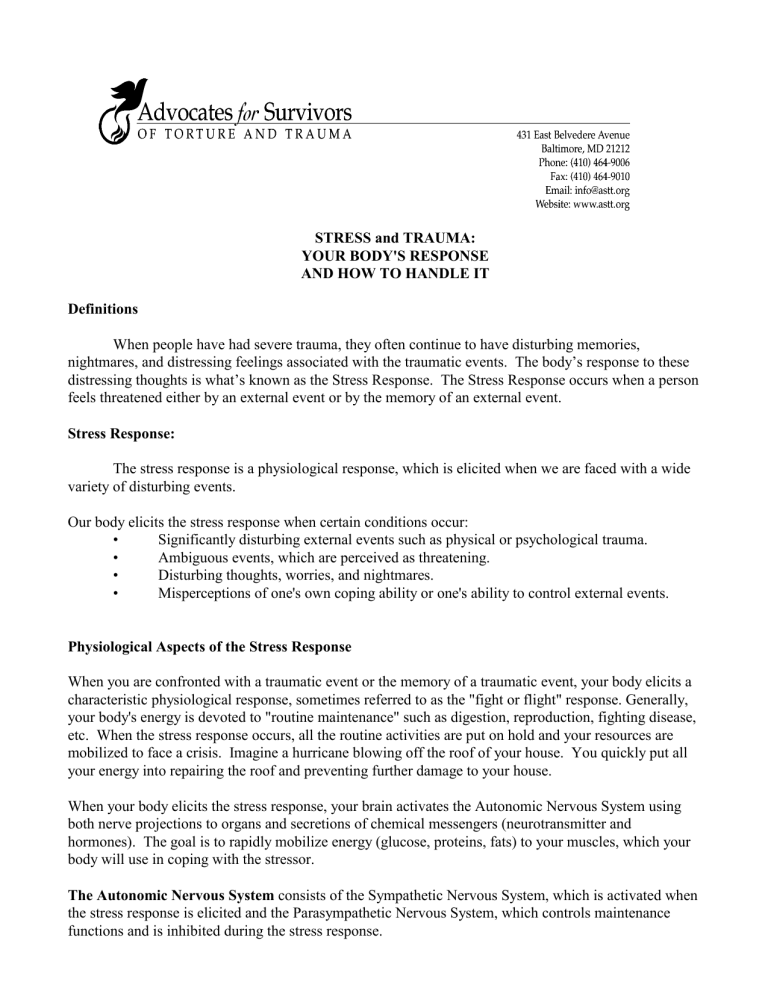
STRESS and TRAUMA:
YOUR BODY'S RESPONSE
AND HOW TO HANDLE IT
Definitions
When people have had severe trauma, they often continue to have disturbing memories, nightmares, and distressing feelings associated with the traumatic events. The body’s response to these distressing thoughts is what’s known as the Stress Response. The Stress Response occurs when a person feels threatened either by an external event or by the memory of an external event.
Stress Response:
The stress response is a physiological response, which is elicited when we are faced with a wide variety of disturbing events.
Our body elicits the stress response when certain conditions occur:
•
Significantly disturbing external events such as physical or psychological trauma.
•
•
•
Ambiguous events, which are perceived as threatening.
Disturbing thoughts, worries, and nightmares.
Misperceptions of one's own coping ability or one's ability to control external events.
Physiological Aspects of the Stress Response
When you are confronted with a traumatic event or the memory of a traumatic event, your body elicits a characteristic physiological response, sometimes referred to as the "fight or flight" response. Generally, your body's energy is devoted to "routine maintenance" such as digestion, reproduction, fighting disease, etc. When the stress response occurs, all the routine activities are put on hold and your resources are mobilized to face a crisis. Imagine a hurricane blowing off the roof of your house. You quickly put all your energy into repairing the roof and preventing further damage to your house.
When your body elicits the stress response, your brain activates the Autonomic Nervous System using both nerve projections to organs and secretions of chemical messengers (neurotransmitter and hormones). The goal is to rapidly mobilize energy (glucose, proteins, fats) to your muscles, which your body will use in coping with the stressor.
The Autonomic Nervous System consists of the Sympathetic Nervous System, which is activated when the stress response is elicited and the Parasympathetic Nervous System, which controls maintenance functions and is inhibited during the stress response.
2
Sympathetic Nervous System activation (coping with the roof blowing off) results in:
•
Increased blood pressure
•
•
Increased heart rate
Increased breathing rate
• Inhibition of digestion, growth, reproduction (sexual drive, ovulation, secretion of
•
•
• testosterone)
Suppressed immune system
Blunted pain sensation
Sharpened cognition
How does the stress response cause problems?
If the stress response is turned on too often, all your energy goes to coping with the threat rather than to the routine functions of your body such as digestion and preventing illness.
As a result of frequently having a stress response, you might find that you are tense and feel tired much of the time. Some people feel pain or tightness in the chest and rapid heartbeat, which are often sign’s of anxiety. Other people experience frequent headaches or other physical symptoms that are related to stress.
A key issue is the body's ability to regulate the turning on and turning off of the stress response. Having the stress response occasionally is no problem. Everyone occasionally has a stress response. However, if the body is directing all its energy to maintaining the hyper-alert state of the stress response, digestive processes, immune functioning, sleeping, etc may begin to deteriorate.
Based on Sapolsky, "Why Zebras Don't Get Ulcers."
2
3
HOW TO HANDLE THE STRESS RESPONSE
There are many ways to handle the stress response. Calming both the mind and the body is important in managing the stress response. Some people find that sharing the fears and distress associated with traumatic memories with a trusted friend, family member, or therapist is helpful. Other people would prefer not to talk about the memories but find other ways of coping with the distress such as reading, regular exercise, prayer, and relaxation techniques. All of these activities can be useful in calming the physical effects of stress. Following are some relaxation exercises that can be used to decrease the stress response.
DIAPHRAGMATIC BREATHING EXERCISE ("Breathing Lessons")
When you are anxious, your breathing becomes rapid and shallow; tension is felt in the muscles.
Diaphragmatic breathing triggers the parasympathetic nervous system, which results in lowered blood pressure, lower pulse rate, lower respiratory rate and an overall reduction in stress.
To perform diaphragmatic breathing:
Lie down on your back or sit in a comfortable chair. If you are lying down place your hands lightly on your stomach. Breath so that you can feel your stomach rising each time you inhale and falling each time you exhale. This is breathing using the diaphragm (a large sheet-like muscle that separates the chest and abdominal regions). If sitting on a chair keep one hand on your chest to see that it remains still and the other on your stomach to see that it rises and falls as you breath in and out.
1. Make your breaths smooth, continuous and leisurely.
2. Breathe effortlessly, slowly and regularly.
3. Focus your attention on your breathing.
4. Breathe through your nose (not your mouth) - but don't press your lips together tightly.
5. Breathe silently.
6. Take the same amount of time to inhale and exhale (you may find it helpful to count while you inhale, e.g. "one one-thousand, two one-thousand, three one-thousand," and do the same when you exhale).
7. PRACTICE THIS REGULARLY EVERY DAY.
"MINI" RELAXATION EXERCISES
Start with diaphragmatic breathing.
Mini Version 1
Count very slowly to yourself from ten down to zero, one number for each breath. With the first diaphragmatic breath, you say "ten" to yourself, with the next breathe, you say "nine", etc. If you start
3
4 feeling light-headed or dizzy, slow down the counting. When you get to "zero", see how you are feeling.
If you are feeling better, great! If not, try doing it again.
Mini Version 2
As you inhale, count very slowly up to four; as you exhale, count slowly back down to one. Thus, as you inhale, you say to yourself "one, two, three, four'" as you exhale, you say to yourself "four, three, two, one". Do this several times.
Mini Version 3
After each inhalation, pause for a few seconds; after you exhale, pause again for a few seconds. Do this for several breaths. from, Domar, A.,Ph.D. Behavioral Medicine Notes, Deaconess Hospital, vol 6, #3, Fall, 93.
TWO BASIC COMPONENTS
THE RELAXATION RESPONSE
* Mental Focusing Device:
Examples: watching one's breath, repeating a word phrase, repetitive muscular activity
* Maintenance of a Passive Attitude toward Distracting Thoughts:
Don't worry about how you're doing.
Continually redirect thoughts
INSTRUCTIONS
1. Choose a focus word, image, or prayer.
2. Sit quietly in a comfortable position.
3. Close your eyes or focus on a spot on the wall.
4. Relax your muscles as fully as possible.
5. Breathe slowly and naturally while repeating your
focus word as you exhale.
6. Maintain a passive attitude. When other thoughts come
to mind, simply say "Oh well" and return to the repetition.
7. Do this once or twice a day for any amount of time up to twenty minutes.
4
5
GENERAL GUIDELINES
When : Anytime except immediately after eating. Benson recommends doing this for five minutes in the morning to create an awareness for the rest of the day regardless of when your regular practice time is. Try to make the practice part of your regular routine.
Where : Anyplace that is quiet and without distractions EXCEPT while Driving!
Position : Sitting up in a fairly straight-backed comfortable chair. Lying down is ok if that’s how you feel most comfortable.
Time: 10 to 20 minutes twice a day is ideal. Some people find it helpful to start with a few minutes and gradually increase by a minute or two per day.
Adapted from Benson and Stuart, 1992A Two-Minute Relaxation Technique
The following exercise can be utilized any time a brief pause in your daily activities is possible. It is especially appropriate to use this exercise before, during and after a stressful event. a. Begin by becoming aware of your thoughts. Note what you are thinking or saying to yourself about this situation. Gently shift your thoughts to yourself and begin monitoring your breathing. Take a slow, deep breath and then exhale slowly. Do it again. b. Scan your body noting which muscle groups feel tense, cramped or tight. Consciously think about relaxing the tension in your muscles. Imagine that with each exhale, some of the tension in those muscle groups flows out of your body; or imagine that gravity is pulling the tension out of your body - imagine the tension leaving your muscles and flowing into the ground. c. Do two "yoga" exercises: (i) slowly rotate your head around in a circular motion once or twice;
(ii) slowly roll your shoulders forward and backward a couple of times. d. Bring to mind a pleasant image or thought - stay focused on this thought for a few seconds. e. Take one more deep breath, exhale slowly and return to your activity feeling refreshed.
Summary:
Take two deep slow breaths and exhale each slowly; Find spots of tension and relax the tight muscles; Do the two yoga exercises (head roll and shoulder roll); Recall a pleasant thought; Take one more deep slow breath.
5

